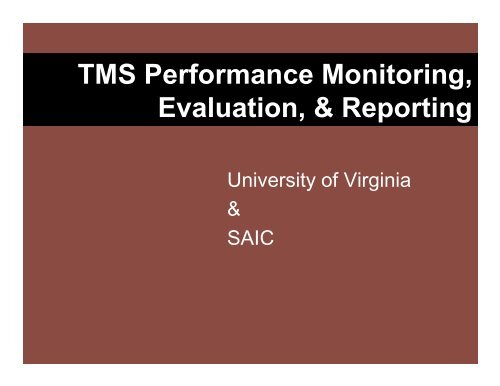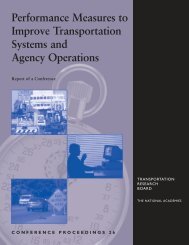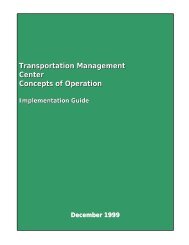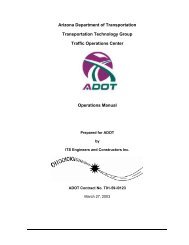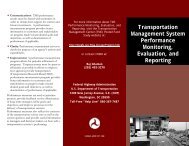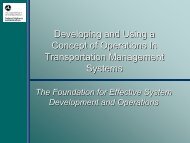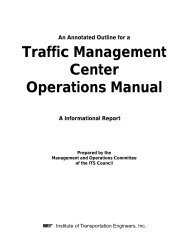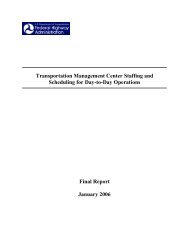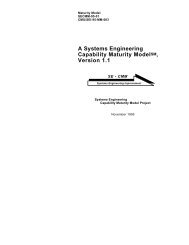TMS Performance Monitoring, Evaluation, & Reporting
TMS Performance Monitoring, Evaluation, & Reporting
TMS Performance Monitoring, Evaluation, & Reporting
Create successful ePaper yourself
Turn your PDF publications into a flip-book with our unique Google optimized e-Paper software.
Transportation ManagementSystems‣ The deployed form of ITS, along withhuman resource contribution, towardtransportation management‣ Includes computer hardware, software,communications, surveillance technology‣ TMC is a physical facility that housescentral equipment, software, andpersonnel that operate <strong>TMS</strong>
<strong>Performance</strong> <strong>Monitoring</strong>,<strong>Evaluation</strong>, & <strong>Reporting</strong>‣ <strong>Monitoring</strong> is ongoing internal processwhere system conditions are examinedthrough collected data‣ <strong>Evaluation</strong> is process where collecteddata is analyzed and compared to setbenchmarks.‣ <strong>Reporting</strong> provides the results of theevaluation for the stakeholders.
<strong>Performance</strong> Measures‣ Provide quantifiable indicators of programeffectiveness and efficiency‣ Help to determine progress towardspecific program goals and objectives‣ Help to determine priority projects,goal/objective refinements, and fundallocation
<strong>Performance</strong> Measure Types‣ Input• Supply of resources‣ Output• Delivery of transportation programs, projects,and services‣ Outcome• Degree to which transportation system meetspolicy goals and objectives
<strong>Performance</strong> Measure TypesMeasureTypeInputTraditional CapacityCapital projects budgetMaintenance and OperationsOrientedPerson-hours of incident responsepatrolsOutput Miles of roadway built Response time to incidentsOutcome Reduced miles of congestion Change in incident-related delay
Criteria for Defining <strong>Performance</strong>Measures‣ Purpose‣ Validity‣ Precision‣ Accuracy‣ Cost-effectiveness
<strong>TMS</strong>/TMC Functions<strong>TMS</strong>Freeway <strong>TMS</strong>Traffic SurveillanceTraffic ControlIncident ManagementSensorsCommunicationCCTVTMC SoftwareWireless TechnologySpecial EventsInformation Sharing/DisseminationOverall <strong>TMS</strong> OutcomesIndividual Hardware ComponentsArterial <strong>TMS</strong>Arterial ManagementWork ZoneSpecial EventsOverall OutcomesSensorsTraffic Signal ControlControllersPre-emption (Receivers)CommunicationTransit <strong>TMS</strong>Information SharingTransit OperationsOverall Outcomes
Freeway <strong>TMS</strong> <strong>Performance</strong>Measures‣ Incident Management –General MeasuresMetricTypeSupplementary NotesCalculationNumber of incidents, byseverity (e.g., fatal, injury), bytype (e.g., crash, stalledvehicle)externaln/an/aPerson hours working for<strong>TMS</strong>/TMC incidentmanagement systeminputBoth infield and TMCNo. People x workinghours per personNumber of respondedcrashes versus total numberof crashesoutputResponded crashes are crashesresponded by state safety patrolor freeway incident responseteamNo. of respondedcrashes over total no.of crashes reportedResponse time to incidentsoutputn/an/a
<strong>Performance</strong> MeasurementProgram‣ <strong>Performance</strong> measurement• Use of quantifiable indicators to determineprogress made toward agency goals andobjectives‣ Program is organized set of measuresthat combine to quantify and evaluate<strong>TMS</strong> goals and objectives
<strong>Performance</strong> MeasurementProgram Benefits‣ Accountability‣ Efficiency‣ Effectiveness‣ Communications‣ Clarity‣ Improvement
Establishing <strong>Performance</strong>Measurement Program‣ Key steps• Identify the vision, goals, and objectives of the agency• Identify intended uses and audiences• Develop <strong>TMS</strong> performance measures and relate to respectiveprograms.• Identify performance benchmarks.• Collect complete, accurate, and consistent data• Analyze and evaluate data• Report data to stakeholders• Identify areas for improvement/change and report tostakeholders
Denver <strong>Performance</strong>Measurement Program‣ Regional Transportation District established in1969‣ 3-tiered performance measurement program• Service Standards• Quarterly Progress Report• Annual Report‣ Measures reviewed using establishedstandards‣ Collect economic and customer satisfactionmeasures
<strong>Performance</strong> Measurement &Data‣ Data is important aspect of performancemeasurement program• Quantity• Quality• Coverage‣ Without “good”data, performancemeasurement program cannot beeffective
Data‣ Success of performance measurementplan relies heavily on quality of data‣ Data requirements must be defined‣ Requirements specify the types of dataneeded for an application, domain, orcomponent
Data Requirement Issues‣ Multiple concurrent incidents‣ Local economy‣ Data should be• Relevant• Timely• Cost-effective‣ Sensor coverage
Data Categories‣ Facility use and performance• Determine if <strong>TMS</strong> is operating at fulleffectiveness‣ Staff activities and resource use• Measure the efficient use of agencyresources‣ Events and incidents that affect normaltraffic conditions
Data Collection‣ Data obtained from 3 sources• Data archives• Modeling/estimation• Manual/automatic data collection
Data Archiving‣ Helps to make long-term evaluationpossible with regard to these categories.‣ Reasons to archive:• Greater and more accurate data• Cost-effective• Cheaper than manual collection• Adheres to current business practices
Data Collection/Archiving Issues‣ Availability‣ Completeness‣ Coverage‣ Quality‣ Standards‣ Reliability‣ Variability
Data Collection/Archiving Issues(Cont’d)‣ Aggregation level‣ Experimental design‣ Storage‣ Metadata‣ Institutional/data sharing
Data Archiving Best Practice‣ PeMS• Freeway performance management systemcreated by Caltrans and UC-Berkeley• Gathers raw, real-time freeway data fromparticipating districts• Established process for processing data• http://transacct.eecs.berkeley.edu
<strong>Performance</strong> <strong>Monitoring</strong>‣ Using performance measurement tovisualize system status‣ Immediate decisions based thisinformation‣ Long-term monitoring can assist withdecision-making• Maintenance• Future deployment
<strong>Performance</strong> <strong>Monitoring</strong> Levels‣ System operators typically focus on dayto-dayoperations of one corridor orroadway‣ Supervisors generally focus on severalcorridors or entire region‣ Managers generally focus on entire <strong>TMS</strong>at high level with daily/weekly reports
<strong>Monitoring</strong> Examplehttp://www.dot.ca.gov/dist11/d11tmc/sdmap/mapmain.html
<strong>Performance</strong> <strong>Evaluation</strong>‣ Analysis of data about the <strong>TMS</strong>‣ Results compared to benchmarkmeasures‣ Used to determine effectiveness ofstrategies, policies, systems, etc.‣ Helps identify areas to improve and justifythe need for additional resources
<strong>Performance</strong> <strong>Evaluation</strong>‣ Allows for the following:• Determination of actual improvement inperformance• Identification of problems that result ininefficiencies• Analysis and prioritization of alternativesolutions• Estimation of the benefits and costs of <strong>TMS</strong>
<strong>Evaluation</strong> Techniques‣ Prior to selecting a tool to evaluate the<strong>TMS</strong>, agencies need to consider thefollowing:• Analysis context (planning, design, ops, etc.)• Geographic scope (corridor, region, etc.)• Capability of modeling facilities (freeway,HOV lanes, etc.)• Ability to analyze various modes
<strong>Evaluation</strong> Techniques (Cont’d)‣ Also must consider• Ability to analyze different managementstrategies (ramp metering, signalcoordination, etc.)• Ability to estimate traveler response tomanagement strategies (route diversion,mode shift, etc.)• Ability to output direct performance measures(safety, efficiency, etc.)• Tool/cost effectiveness
Before-and-After <strong>Evaluation</strong>‣ Most common method to evaluate <strong>TMS</strong>effectiveness‣ Studies effects of particular managementstrategy by studying performancemeasurement results from before andafter the implementation
Before-and-After <strong>Evaluation</strong>Issues‣ Difficulty in distinguishing effects of oneimprovement when multiple ones weremade at once‣ Time needed for drivers to adjust tochange‣ Time-related factors‣ Regression to the mean
Best Practice‣ Before-and-after study of Phase I of I-10/I-17 FMS in Phoenix area‣ Studied several MOEs for 57 km offreeway fitted with ramp meters, VMS,loop detectors, CCTV cameras‣ 2-6% travel time improvement alongseven-mile stretch with ramp meters
<strong>Performance</strong> <strong>Reporting</strong>‣ Allows for communication withstakeholders about system performance‣ Helps in decision-making process‣ Allows for tracking of <strong>TMS</strong> progress‣ Creates sense of accountability
<strong>Reporting</strong> Trends‣ Using the media‣ Daily/weekly intranet postings‣ Quarterly/monthly public reports on theInternet‣ Formal biannual/annual reports forgovernment/business officials‣ “Notebooks”keep key decision-makers upto date on agency performance/goals
<strong>Reporting</strong> Best Practice‣ WSDOT’s “Gray Notebook”‣ Explains agency’s planning process andrationale behind decision-making‣ Assesses statewide conditions‣ Tracks assortment of reliability andeffectiveness measures for routine review‣ Has become important source for statelegislators and other agency stakeholders
Handbook Overview‣ Handbook serves as a technical referenceon performance monitoring, evaluation,and reporting‣ Provides ways for planning,implementing, and sustaining aperformance measurement program‣ Discusses issues related to datacollection and archiving
Handbook Overview (Cont’d)‣ Intended audience include representatives of• State DOTs• MPOs• Transit agencies• Enforcement agencies‣ Intended audience is also anyone with role in<strong>TMS</strong>/TMC performance monitoring, evaluation,and reporting
Chapter 3TMC FunctionsChapter 4<strong>TMS</strong> Goals andObjectivesChapter 3Budget andResourceAllocation,ProjectPrioritizationHigh-levelTasksChapter 3/4Define<strong>Performance</strong>Measures &Set BenchmarkChapter 3StakeholdersChapter 5DataRequirementsData-drivenTasksChapter 5Data CollectionandProcessingChapter 5Data ArchiveChapter 6<strong>Performance</strong><strong>Monitoring</strong>Chapter 6<strong>Evaluation</strong>Chapter 3DecisionMakersMotivateChangesChapter 3<strong>TMS</strong> EfficiencyTasksChapter 6Report<strong>Performance</strong>MeasuresPublic
Handbook At-A-Glance‣ Chapter 1 –Introduction. Defines thebackground, purpose, and scope of thehandbook and the intended audience.‣ Chapter 2 –Overview of <strong>TMS</strong> <strong>Performance</strong><strong>Monitoring</strong>, <strong>Evaluation</strong>, and <strong>Reporting</strong>.Provides a high level overview of <strong>TMS</strong>performance monitoring, evaluation, andreporting and how they relate to <strong>TMS</strong>s.‣ Chapter 3 –<strong>Performance</strong> MeasurementProgram. Discusses the purpose andimportance of, and need for a <strong>TMS</strong>performance measurement program.
Handbook At-A-Glance‣ Chapter 4 –Agency Goals and <strong>Performance</strong>Measures. Presents typical performancemeasurement goals of <strong>TMS</strong>-related agencies.Also provides high-level performance measuresby <strong>TMS</strong> functions and calculation methods ofsuch performance measures.‣ Chapter 5 –Data Requirements, Collectionand Archiving. Provides performance measuredata requirements and best practices for datacollection, evaluation, and reporting.
Handbook At-A-Glance (cont’d)‣ Chapter 6 –<strong>Performance</strong> <strong>Monitoring</strong>, <strong>Evaluation</strong> and<strong>Reporting</strong>. Explains various monitoring and evaluationmethodologies and processes related to <strong>TMS</strong> performance.Discusses recommended reporting techniques, formats, andfrequencies for reporting <strong>TMS</strong> performance.‣ Chapter 7 –Self- Assessment. A checklist of questionsdrawn from case studies. Can be used by TMCs to assessthe status and performance of the <strong>TMS</strong>. Also includes somebest practice examples from selected agencies.‣ Appendix A –Survey Questionnaire and Results‣ Appendix B –Contact List of Traffic ManagementCenters
Other Subject Information‣ Fact sheet‣ FAQ‣ Tri-fold brochure‣ Primer‣ Available athttp://tmcpfs.ops.fhwa.dot.gov/Projects.htmFHWA-HOP-07-126


